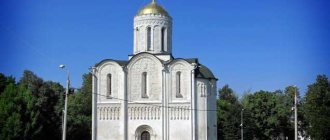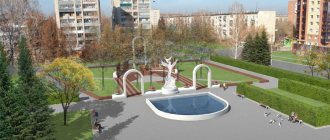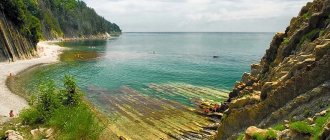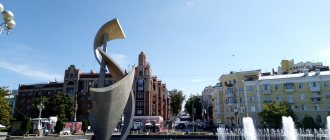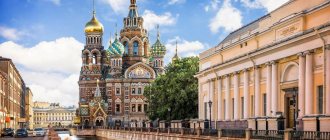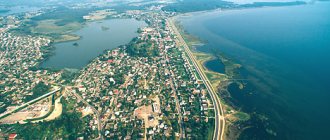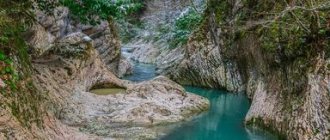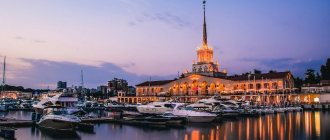On the Black Sea coast there are several districts of the city of Sochi, one of which is the Khosta microdistrict, famous for its cultural and architectural monuments. Attractions Khosta annually attracts thousands of tourists who want to get acquainted with the history of our country, broaden their horizons, receive medical treatment and simply enjoy warm days in picturesque places.
A few facts about the Host
- Khosta became part of Sochi in 1951.
- Khosta is located on the banks of the river of the same name, at its confluence with the Black Sea.
- Khosta is located between Adler and the Central District of Sochi.
- There is a railway station in Khosta through which long-distance trains and electric trains travel.
- The population of Khosta is about 20 thousand people, not counting vacationers.
Treatment with passion
Stalin, Budyonny, Voroshilov, Brezhnev - what unites these famous people? All of them improved their health at the Matsestinsky resort, which is located in the Khostovsky district. The main remedy is the world famous Matsesta hydrogen sulfide mineral water. It contains more than 20 chemical compounds. Mineral baths help normalize blood pressure and metabolism in the body. Local water is used to treat diseases of the nervous system, musculoskeletal system, and skin.
Famous health resorts are located in Khosta
The first resort using local mineral water was opened back in 1902. They called him "Matsesta". It was estimated that over the entire period of operation of the hydropathic clinic, 220 million procedures were performed! And the first hosting hotel, which would now receive the prefix “SPA,” appeared seven years later. It was called the “Caucasian Riviera” and had an electric light and water therapy clinic, mineral baths, a concert hall, a casino, a restaurant and even a reading room. Currently, there are about a dozen sanatoriums in Khosta.
As befits a seaside resort, Khosta has many hotels and several public beaches, including “Wild” and “Wild”. The latter is especially popular with fishermen and divers, since the sea water here is crystal clear. Boarding houses and sanatoriums have their own beaches. The Breeze Hotel has a water park of the same name.
Stalin's dacha residence
Website: dachastalina.ru Address: Sochi, Kurortny Avenue 120/1.
Joseph Vissarionovich Stalin had 20 personal country residences, but most often he visited the Sochi dacha. His high-ranking guests, the top officials of other states, also visited here, and the statesman’s family lived here. The house was built in the best location in the area, which Stalin personally chose. The project was led by architect Miron Merzhanov, and already in 1937 the residence was ready.
The site at an altitude of 160 meters above sea level grew up at the very top of the mountain between Matsesta and the Agur Gorge. It is surrounded by 50 hectares of forest park area, which now belongs to the Sochi National Park. And the dacha itself was painted with special green paint so that the house would not be visible from the air.
Now the estate is located on the territory of the Green Grove sanatorium. In the 1990s, a museum dedicated to the life of the leader and the difficult era of those years was opened within its walls. Furniture from the 1930s, photographs and gifts that belonged to Joseph Stalin have been preserved here.
Near Khosta is Abkhazia, where you can see several more of Stalin's dachas. One is located in Tsandripsha - object No. 18 “Cold River”, the other in New Athos - object No. 8 “Swallow’s Nest”, another one is on Lake Ritsa.
History of Hosta
Very suitable and quite comfortable places to live in the valley of the Khosta rivers were chosen by man for another 15-20 thousand years
back.
the dolmens
found in these places .
Several surviving dolmens can be seen in the Krasnaya Polyana area
In the first millennium BC. Greek merchants began to trade with the local population
, very intensively carrying out their colonization to the east. Greek products in the form of wine, olive oil, and lacquer ceramics were in good demand, and local residents sold nuts, honey, yew and boxwood to the Greeks.
Khosta in the form of the settlement Khamysh existed on the Black Sea coast back in the Middle Ages
. It belonged to the Abkhaz princes. From the 8th-10th centuries, the ruins of an ancient fortress have been preserved, which once guarded the entrance to the mountain gorge and valley. Today these fortress remains can be seen in the Yew-Boxwood Grove.
The ruins of the ancient Khosta fortress are preserved in the Tiso-Boxwood Grove
In the 12th century, a Genoese trading entity called Casto was founded here. Subsequently, tribes of the agricultural peoples of the Ubykhs lived here -
ancestors of the Circassians, Abazins and Abkhazians. The name Khosta translated from Ubykh means “boar gorge”.
After the end of the Caucasian War, which was fought during 1817-1864
between Russia and the peoples of the North Caucasus and ended in the today famous village of Krasnaya Polyana, the Ubykhs of the Black Sea coast emigrated to the Ottoman Empire, where they eventually assimilated with the Turks. It is believed that the total number of Ubykhs who left their historical homeland was approximately 75 thousand people.
After the Caucasian War, thousands of local residents left the region forever
The settlements abandoned by the Ubykhs gradually began to be reclaimed by Russian residents. In 1899
the city of Khosta
on the site of a new Russian settlement , in which city estates and summer cottages of aristocrats of count and princely families, famous Russian political and artistic figures, etc. very soon appeared.
At the end of the 19th century, Khosta became a popular resort settlement
At the turn of 1905-1906
The power of the Sochi Republic was established in Khosta. After the revolutionary events of 1917 and the establishment of Soviet power, by February 1918, there was a massive nationalization of private properties and their transfer into the hands of the people.
After the Civil War, many dacha buildings were repurposed as sanatorium-resort institutions intended for workers' recreation. In the former Mansion of Colonel Kvitko, the Krasny Sturm Sanatorium is located, and at the Dacha of Gerasimova, a Tambov landowner, the Progress Sanatorium is located.
Kvitko's dacha became the Krasny Sturm Sanatorium for NKVD employees
In the 30s, a master plan was developed for the transformation of the Matsesta resort, which was an integral part of the Khostinsky district. Based on this plan, reconstruction
Khosta itself, in which new health resorts appeared (“Cape Vidny”, “Aurora”, “Volna”, etc.), a seaport, new houses, parks, public gardens, etc.
Sanatorium "Volna"
, for example, built in 1937, was built by analogy with the famous Petrodvorets. There were cascades of waterfalls and park stairs. Today this sanatorium is not functioning. In 1936, the Aurora sanatorium was also built.
The Volna sanatorium became one of the most luxurious sanatoriums in the 30s
Asphalt streets appeared in the city, water supply was installed in the houses, and the bed of the Khosta River was improved. Great importance was attached to landscaping
resort area. The park areas laid out in those days have now grown and turned the city into a continuous green oasis.
Any street in Khosta is part of a green park area
Today, the Khostinsky district between the Kudepsta and Agura rivers is an integral part of Greater Sochi. This is one of the famous resort places in the Krasnodar Territory, which has sanatoriums and boarding houses for improving health, numerous beaches for relaxation, as well as many famous and not so famous attractions that curious tourists love to visit.
Art gallery “A.A.S. Plastic in wood"
Address: Sochi, Sovkhoz Primorsky microdistrict, Zvezdnaya street, building 1.
The unique private art gallery of A. A. Sobol was opened by a civil engineer and sculptor who has been carving wood for more than 35 years. There are about 500 works made using original techniques on 5 floors. Alexander Alexandrovich uses walnut, pine, pear, maple and other tree species as materials.
What will we take with us as a souvenir?
Souvenirs in Khosta are quite typical: products and crafts made of wood, beads, Russian nesting dolls, home interior items made using the decoupage technique, handmade jewelry, costume jewelry, towels with artistic embroidery, soft toys, etc.
Next to the Luch House of Creativity, exhibitions and fairs of folk crafts are held. Every visitor has the opportunity to learn about the secrets of local craftsmen involved in decorative and applied arts and purchase their works. Often, the material itself from which the souvenir is made is not as important as what is depicted on it. What emotions does it evoke in memory? And Khosta with its picturesque surroundings cannot but evoke warm feelings in everyone who has been here.
Mount Akhun
The main attractions of Khosta are the Eagle Rocks, reaching a height of 380 meters. Among them stands out Mount Akhun, which towers above all of them, since its height is 663 meters above sea level. An observation deck was built on it in 1936, which was a 30-meter tower. From here you can enjoy panoramic views of the rocks and their surroundings.
The name of the peak is associated with the legendary god Akhyn, who lived in these places. Tradition says that he was huge and carried a long staff with him everywhere. Once the daughter of an influential gentleman fell in love with him, she married the deity, despite all the protests of her father. Then he got to his son-in-law’s staff and sawed it off. The hero did not notice anything, and when he stepped over the next ditch, the stick broke. Akhyn fell from a great height and died.
The best way to get to Khosta
By plane - to Adler airport. From the airport by bus, minibus or train from Adler to Sochi (but you should know that you first need to get from the airport to Adler railway station). The railway track is laid along the entire coast. Train intervals are 30 minutes in the daytime and 1 hour in the evening. Minibuses run from Khosta station in all directions.
Vorontsov caves
The Sochi National Park contains the longest karst cavity in the Krasnodar region, its length is more than 11 kilometers. It got its name from the village of Vorontsovka, which lies nearby. In addition to the cavity, the Vorontsov system also includes other caves: Kabany Proval, Dolgaya and Labyrinthovaya caves. All of them are connected by natural tunnels.
The attraction is famous for its archaeological finds. Here scientists have discovered artifacts from different eras, including the Late Paleolithic. These include sites of ancient people and even the bones of cave bears.
Now it is possible to get inside the cavity in several ways: the Vorontsov Caves have 14 entrances at different heights relative to sea level. Visitors are provided with lighting and stairs, and excursions are provided. In several halls you can see columns, stalactites and stalagmites.
Through the pages of the Red Book
The Khostinsky district borders the Sochi National Park, where most of the plant and animal species growing and living in these areas are represented. There are 11 mammals listed in the Red Book. Mostly these are bats. Among birds, 12 species are under protection. Among them are the golden eagle, the snake eagle, the Caucasian black grouse and others. 4 species of reptiles are listed in the Red Book. Of these, you should be wary of the vipers Dinnik and Kaznakov.
Sochi National Park
Even more plants listed in the Red Book. In total there are about 50 species. It is worth noting the Caucasian lily, oriental poppy and magnificent colchicum, which are a real decoration of mountain landscapes. Of course, these rare representatives of the flora cannot be found in the city. To do this you will have to climb the mountains. The national park staff have developed 28 excursion routes especially for tourists.
Yew-boxwood grove
A huge environmental facility that belongs to the Caucasus Biosphere Reserve named after. Kh. G. Shaposhnikova. Its area is 300 hectares. The main feature of the grove is relict berry yews and evergreen Colchian boxwoods, preserved almost unchanged since the pre-glacial period. Scientists claim that these plants were common in Europe 18-25 million years ago.
The reserve was taken under the protection of UNESCO; at the moment, more than 400 species of plants grow here. Sometimes you come across animals: wild boars, jackals, roe deer, foxes, lizards, hedgehogs. On the territory of the grove you can also find the sights of Khosta: an ancient fortress, the Devil's Gate canyon and an unnamed cave.
Agur waterfalls
The Sochi National Park is home to the famous Agur Waterfalls, a natural attraction that can be found just 13 kilometers from the central part of Sochi. They are 3 groups of waterfalls connected by a path. It, in turn, was carved into the rock in 1911. Later, handrails appeared for the safety of tourists.
The Lower, Middle and Upper waterfalls differ in height, width and flow power: they fall from a height of 12 to 23 meters. You can admire the natural attraction at any time of the year, but it is recommended to visit these places in the spring, when the Agura River is at its fullest.
There is a legend that Prometheus was chained to a rock in these places, and the girl Agura volunteered to help him. But the god Akhyn found out about her, who was angry for disobedience and turned the good girl into a river, which was later named after her. Now on the Eagle Rocks there is a statue of Prometheus, depicted with powerful arms, but chained.
Sights of Khosta and its neighborhood
Khosta, like any settlement in the Krasnodar Territory, has many of its own territorial attractions, mostly consisting of natural objects
.
Map of the main attractions of the Khostinsky district
In Khosta itself and its surroundings, inquisitive tourists will always find something to see and where to go. After all, the constant desire to see new places and make personal discoveries has always been inherent in domestic travelers.
Museum of the History of Khostinsky District
Address:
st.
50 years of the USSR, 28 While relaxing in Khost you can visit a small local history museum
. It is located in an ancient building from the early 20th century, which once housed the Khosta People's House. Then the premises were given to the Luch cinema, after which the Stroitel club moved in.
In the local history museum you can get acquainted with the history of Khosta
Since 1995, museum exhibitions have been opened on the premises of this building, telling about the history of the Khosta resort. This museum is open every day except Monday from 9 a.m. to 6 p.m.
. Ticket prices are around 100 rubles.
Church of the Transfiguration of the Lord
Address:
Shosseynaya Street, 9 A
Among the architectural sights of Khosta, I would like to draw your attention to the ancient Orthodox church built in the city in 1914
.
The initiator and active organizer of the construction was the wife of I. Shcheglovitov, who was the then Minister of Justice - Maria Feodorovna
.
The Transfiguration
Church is an architectural monument of the early 20th century.
The fact is that the wealthy Shcheglovitov family had a dacha in the Khosta area, and Maria Feodorovna really wanted to build an Orthodox church not far from their summer estate. The woman turned out to be very active - she organized a board of trustees
, she took an active part in his work to raise funds for the temple. Having learned about the construction of the Khosta church, the emperor himself ordered the Synod to transfer four thousand rubles in gold to the construction fund.
It was decided to build the Church of the Transfiguration of the Lord in a modern neo-Byzantine style
, like the Jerusalem Church of the Holy Sepulcher (architect A. Ion). The entire temple was built from sedimentary rock - sandstone, against which the white porch in the form of a portico with columns and arched windows stood out in very contrast.
The brilliance of the temple domes is clearly visible against the background of the greenery of the Khosta parks
A garden plot was laid out near the temple, where tangerine, orange and olive trees were planted, which are still actively bearing fruit today. The well-kept garden is also planted with flowers and is very beautiful. Some call it the Garden of Gethsemane.
After the revolution, the fate of the temple was traditional for Soviet times. It was looted and closed
. What saved the building from complete destruction was the fact that it was used for the needs of an automatic telephone exchange. At the beginning of the 21st century, returned to believers, the temple was restored and began to hold services.
The interior of the Church of the Transfiguration of the Lord has been recreated
It is interesting that this temple was built by the famous singer Yuri Shatunov
three very old and valuable icons were donated, which became the only pre-revolutionary church rarities. In addition, the temple has holy icons with the relics of the apostles Peter and Thomas, Patriarch Tikhon, Matrona of Moscow and St. George the Victorious.
This temple building, which is an architectural monument of the early 20th century, can be visited from 8 to 18.30
daily. There is a Sunday school for children at the temple.
Dacha Kvitko – haunted house
In many places there are peculiar haunted houses. In Samara there is the famous House with Elephants, in Pyatigorsk there is Elsa’s Dacha, but the St. Petersburg ghosts live in the Palace - in the mystical Mikhailovsky Castle. In Krasnaya Polyana, located next to Khosta, there is a Haunted Restaurant, and in the Khosta district, the Haunted House is the former country cottage of retired Colonel A. Kvitko.
Former dacha of Colonel A. Kvitko now abandoned Haunted House
This completely abandoned and dilapidated building is now located on the territory of the state farm village of Primorsky, which can be reached from the bus stop “Sanatorium “Red Storm”” in a matter of minutes.
Of course, this is not a museum or an official tourist site. This dilapidated building witnessed the most difficult and significant changes in the life of the country, and walking through its territory, you can remember these times and the people who lived in them. After all, you don’t choose times, you live and die in them...
For more information about this object, see – Colonel Kvitko’s dacha
Frunze Park
Chernomorskaya, 11
A park area of about 3 hectares, named after Frunze, is like a continuation of the Primorsky Park of the city of Sochi towards the Khostinsky district. It began to form here at the end of the 19th century.
as the estate of the Vereshchagin family and was formerly called
Vereshchaginsky
. Today this picturesque and pleasant park for walks is limited on the land side by Chernomorskaya Street.
Frunze Park is one of the popular vacation spots
Like the territory of the Primorsky Park in Sochi, Frunze Park is divided into the Upper and Lower parts. In the lower part there is a small river flowing through which the Bridge of Expectations
.
During the formation of the park area, many oaks and hornbeams, chestnut and beech trees that were already growing wild here were initially left here. In addition, exotic varieties of palm trees, magnolias, forsythia, oleanders, etc. were planted. A big role for the park was played by one of the famous gardeners of that time - N. Klihu
, who looked after the plants like children, and even organized a water supply system with a pump for constant watering in the park.
In the 30s of the 20th century
In the park there were grounds for playing tennis and croquet, as well as for gymnastics. During these same years, the Park began to bear the name Frunze. It was very popular and crowded. Today it is much calmer and quieter here. Tourists are attracted here by the proximity of the beach area, as well as the silence and beauty of this natural area.
The main attractions of this park are the building of the Summer Theater
, the square in front of which is decorated with a 4-tier fountain, and sculptural busts of famous Russian composers, such as P. Tchaikovsky, M. Glinka, N. Rimsky-Kormakov, forming a kind of
Composers Alley
.
The Summer Theater building is the architectural dominant of the Park area
There is also a monument to the founder of the Sochi resort, Minister of Agriculture and Property Relations A. Ermolov
. By the way, this park was at one time called Ermolovsky (from 1910 to the 30s of the 20th century). You can learn about the role of this energetic person in the development of the Sochi-Matsesti resort in the article - A Brief History of Sochi.
In addition, in the park you can see the Memorial to the Heroes of the Soviet Union of the city of Sochi - “Cranes”. There is also a small tea plantation here. The Frunze Park ends with the 8-column Rotunda, which serves as an architectural decoration and a wonderful viewing platform.
The park's rotunda is one of its most romantic places
This Rotunda was erected here to replace the lost Chinese gazebo of the pre-revolutionary period.
Summer Theater
Chernomorskaya Street, 11
In this beautiful building, built in the late 30s in the Frunze Park, you can quite pleasantly spend one of the Sochi evenings if you familiarize yourself with the event poster in advance.
It’s a pleasant place to relax in the theater hall, which is open on all sides.
Here, in cozy soft armchairs under a glass roof of an open space, you can listen to performances by Russian pop stars, see a performance by the Moscow Operetta Theater, famous comedy groups or other concerts.
Navalishchenskoye Gorge
A very interesting and picturesque natural monument of the Khostinsky district
The Navalishchenskoye Gorge
is considered to have formed as a fault in the earth’s crust even before the Jurassic period began. It stretches for more than one and a half kilometers, and the height of its side rocks can reach up to 150 m.
Navalishchenskoye Gorge is one of the iconic natural attractions
yew trees grow here
, and other rarities of the plant world. And along the bottom of the canyon the waters of the Khosta River flow, forming numerous creeks and small lakes along the way. These cool natural ponds are a great place to cool off on hot days.
This canyon is located near the village of Krasnaya Volya
, which once bore the name of Navalishin, the founder and first resident of the village.
If you decide to visit this natural monument on your own
, then you need to get from Khosta to Krasnaya Volya by bus 128.
Next, move along V. Ulyanov Street, from which turn onto Lesnaya Street, then follow the dirt road that continues it to the barrier, where you will have to pay an entrance fee of around 200 rubles, after which you can enter the territory of the Sochi National Park
. Because this is where this attraction is located.
This gorge is part of the Sochi National Park
In your car
You can get to the dirt road and then walk. There is another option to take an excursion from the place of your summer deployment.
After the barrier, along the stairs, as if decorated with luxurious ferns, you need to go down into the gorge itself, where you immediately get the feeling that you are in the scenery of Jurassic Park
and a living dinosaur is hiding behind the nearby trees.
Scheme of the tourist route along the Navalishchensky Gorge
The tourist route along the Navalishchensky Gorge is circular, so you can go in any direction. Everywhere there will be beautiful views with waterfall cascades, giant boulders, rock formations, relict vegetation and unequipped karst caves. The route ends at the White Rocks
and an equipped picnic area with gazebos and benches. There you can relax, eat and even wash in the bathhouse. Naturally, for additional money.
It must be borne in mind that the descents and ascents in the Navalishchensky Canyon are quite steep and difficult to overcome without comfortable sports shoes and some physical training. Particularly advanced tourists can take a trip to the Lower Navalishchensky Canyon
. To do this, you need to move downstream of the Khosta and have special equipment with you. Or you can get there from the village of Khleborob along the right branch of Tsentralnaya Street to the picnic clearing, from where the path continues down the water and ends with a four-meter waterfall.
The Khosta River from the gorge rushes into the Yew-Boxwood Grove
This natural attraction is a geological part of the formation of Mount Akhun and the Tiso-Boxwood Grove, the connecting link with which is the Khosta River.
Yew-Boxwood Grove
Thanks to the unique warm and humid microclimate, on one of the terraces of the Navalishchensky gorge of Khosta, a wild territory of relict plants was formed, in appearance reminiscent of Colchis forests - the Yew-Boxwood Grove. In these primeval thickets, very rare and ancient yew and Colchian boxwood, beech and hornbeam, mosses, vines and Colchis ivy grew side by side.
Very ancient, prehistoric plants grow in the Yew-Boxwood Grove
Since 1931
The territory of the grove has been declared a protected part of the Caucasus Nature Reserve.
Today here you can see thousand-year-old yew trees
and touch soft relict moss, admire 400-year-old
beeches
and smell the linden aroma.
But you won’t be able to admire the boxwood thickets. For boxwood was exterminated by a terrible pest - the “boxwood moth” in 2012-14
.
And, nevertheless, a walk along the tourist routes of the Yew-Boxwood Grove will be pleasant and educational in all respects. Moreover, here you can also visit the ruins of a Medieval fortress
and a small
Museum of Caucasian Fauna
. And there are too many picturesque places for selfies to be found here!
There are a lot of cozy and beautiful corners in the grove
More information about the routes and the most interesting and even magical plants of this attraction can be found here - Yew-Boxwood Grove
Mount Akhun
The Agura River flows west of Khosta
, the formation of which is associated with the legend of Prometheus, chained to local rocks.
These rocks themselves, called Eagle
or White, are one of the local natural attractions.
Prometheus was once chained in the Eagle Rocks
The Agura River, fast and impetuous, flows through another natural attraction - the Agur Gorge
or a canyon formed as a result of the tectonic fault of Mount Bolshoi Akhun.
On its rocky path, Agura creates waterfalls and lakes. And these Agur waterfalls
are another worthy natural monument, to which hiking trails have been laid. And on Agura there are hydrogen sulfide springs, caves and a lot of interesting things!
If on one side the Agur Gorge is fenced with Eagle Rocks
, then on the other side are the rocks
of Bolshoy Akhun
, which is a very famous landmark of the area.
Akhun's most popular site is the Watchtower
, built on its top by order of Stalin in 1936. There are many other legendary places and tourist sites here.
The observation tower of Bolshoi Akhun is a very popular tourist attraction
For more information about the Agur Gorge, Agur Waterfalls, Eagle Rocks and Mount Akhun, see – Mount Akhun and its attractions
Vorontsov Cave
A striking natural attraction is the Vorontsovskaya Cave, located above Khosta in the area of the village of Vorontsovka. In fact, this is a complex consisting of 4 interconnected caves, but only one of them is available for tourist inspection - the first or Vorontsovskaya. The rest (Dolgaya, Labyrinthovaya and Boar Prolapse) are visited only by experienced speleologists.
Vorontsovskaya Cave is equipped for tourist inspection
A walk through the cave halls, each of which is different from the previous one, makes an indelible impression and creates a feeling of belonging to a real miracle.
Read more – Vorontsov Cave
Arboretum
Address:
Kurortny Prospekt, 74
Another unique natural attraction of the Khostinsky district is the famous Sochi Arboretum, where a huge collection of rare representatives of subtropical flora and fauna is collected. Almost every vacationer in the Krasnodar region strives to visit this luxurious garden and park creation of human and natural hands.
Every person should visit the Sochi Arboretum at least once
The park territory is divided into Upper
and
Nizhnyaya
, connected by a cable car, travel on which is paid separately.
The entrance to the Arboretum is located on the lower side of the Upper Park. In principle, you can spend the whole day in this amazing place. There are cafes
, food outlets and souvenir stalls. Unique plants, neat paths, sculptures and architecture of pavilions, and most importantly wonderful fragrant air - everything here contributes to creating a good mood, relaxation and a real vacation time.
It’s good to take a walk through the Sochi Arboretum in any weather
The arboretum, which is the property of the Sochi National Park, is located in the Svetlana microdistrict of Khosta, where you can get from any locality by various buses to the “Circus” stop
.
You can visit the arboretum daily from 8 a.m. to 7
p.m. Ticket prices range from 120-250 rubles. Some exhibition pavilions are open on weekends, which is better to find out on the official website.
From the Lower Park to the Upper Park you can take a cable car
By the way, a walk through the Arboretum can be combined with a visit to the Sochi Circus
, which is located very close to this natural attraction.
Read more – Sochi Arboretum
Matsesta
On the territory of the Khostinsky district there is the famous balneological resort of Matsetu. Visiting this place is also very interesting. After all, these are real Sochi Mineral Waters!
The symbol of Matsesta is the sculpture “Girl Hugging a Mountain”
This resort place, full of medical and sanatorium institutions, has a special aura and an amazing history. Here you can just take a walk, drink medicinal water, and admire the southern vegetation. And if you wish, visit Matsestinsky attractions in the form of tea plantations, Zmeykovsky waterfalls, Matsestinsky valley and Matsestinsky springs.
Matsesta is the real Minvody of the Krasnodar Territory
You can also visit the Natural Museum
or to the “Aquarium”, take a photo near the sculpture “Girl Hugging a Rock”, admire the architecture of the resort buildings erected here also during the period of Stalin’s rule, etc.
For more information about the history of Matsesta and the attractions of the Matsesta resort, see - What to see in Matsesta
Stalin's dacha
In the Matsesta area, on the road to the Agur waterfalls and Mount Akhun, there is one of the many Stalinist dachas. It is believed that Stalin's dacha in the Sochi region was especially loved by him.
The Sochi Dacha near Matsesta was especially loved by Stalin
Today there is a museum here, several rooms of which will tell about the everyday side of the life of the “father of nations.” How to get to this memorial museum and what you can see there - see Stalin's Dacha.
Kudepsta stone
This megalithic landmark, located near the village of Kudepsta
Khostinsky district, is an iconic block of sandstone. Some historians attribute this artifact to the dolmen culture.
The stone is one of the mysterious Khosta attractions
The purpose of this interesting structure is not precisely known. The base, quadrangular in plan, has different heights on opposite sides. On the eastern side there are peculiar “seats”
- knocked-out recesses. There are two of them, and between them there is a separator like an armrest. Approximately these seats are located just opposite the point of sunrise in winter. Behind the “seats” there is an inclined “back”.
On the Kudepsta stone itself and on others located close to it, there are hollowed out holes of different sizes. Why they were made and in what historical period remains an unsolved mystery.
Today the stone is covered with both ancient symbols and modern inscriptions
You can come to Kudepsta to admire this magical monument from Adler on the 60th, and from the city of Sochi on the 122nd bus. From the stop, move towards the 9-story building, then walk between the concrete wall and the fence and move towards the forest.
The path to the stone is marked along the entire path
Along the forest path you need to climb up all the time, admiring the redwood trees and inhaling the pine aroma along the way. The path will lead to a clearing with a mysterious cult object.
If you wander around the surroundings of the cult stone, you can find a small and pretty Turtle Lake.
Not far from the Kudepsta stone is Turtle Lake
Devil's Gate Canyon
The narrow canyon “Devil's Gate” reaches a length of 50 meters, but the distance between the rocks rising on the sides of the riverbed does not exceed 5 meters. This is why the natural landmark got its name. However, walks through the canyon bring only pleasure to visitors: the mountain river is transparent and the plants are diverse. In addition, tourists do not require special equipment or physical training.
On the territory of this Khosta attraction there is a clean and small lake, only 12 meters in diameter. Its depth is only 4 meters, but it is cold to swim in it even in summer, just like in the mountain river Khosta, which flows through the canyon.
Water park "Breeze"
Address: Sochi, Khosta, Zheleznodorozhnaya st., 9.
Not far from the seashore there is the Breeze water park, where you can swim in children's or adult pools and ride water slides of various levels of extremeness. Adult thrill-seekers prefer the Toboggan and Kamikaze rides. For kids there is a mushroom-waterfall not only for a fun pastime, but also for hardening.
There are lifeguards and instructors on duty at the water park, and animators work. You can rent sun loungers, have a snack in a cafe or change clothes in the shower.
Khostinsky Park of Culture and Leisure
Address: Sochi, Khosta, st. Platanovaya, 8a, Khosta.
For a calm and measured holiday in the Khostinsky district there is a park where you can escape the summer heat and have fun on the rides. Most of the entertainment was created back in 1978. These include a race track, carousels for the little ones, a swimming pool with bumper boats, a Ferris wheel, extreme trampolines, and a shooting range. There is an orientation map and walking paths.
In the summer, as well as on weekends and holidays, entertainment events are held in recreation areas: competitions, concerts and performances by animators. Snacks, ice cream and soft drinks are sold.
Matsestinskiye waterfalls
The picturesque waterfalls in the Sochi National Park get their name from the river of the same name, which flows in the Khostinsky district. There is a legend that many years ago the family of the mountaineer Kerenduk lived in this valley with springs. He gave birth to an incredibly beautiful daughter, who was named Matsesta, which was translated from Shapsug-Ubykh as “fire water.” She sacrificed her life to find healing blue water and cure her parents' illnesses.
To this day, people come here not only for mineral water and medicinal mud that can heal respiratory diseases, but also for the local beauty. The natural ensemble, named after Matsesta, includes 18 waterfalls. Each of them has its own name, here you can find “Oyster Mushroom”, “Uncle Styopa’s Mustache”, “Pony Tail”, “Dwarves” and others. Nutria and swans live in the waters, and broom, boxwood, and laurel grow along the banks.
Under the wing of Greater Sochi
Greater Sochi is a real seaside metropolis. Its total length reaches 100 kilometers! There is no longer city in Russia. It absorbed several small towns, villages and villages. The inner-city district of Khosta is also part of the famous resort city, located between the center of Sochi and Adler. The natural boundaries of the Khostinsky district are the Kudepsta and Vereshchaginka rivers.
The coastline of Khosta is 13 kilometers. Almost all of them are beaches. Houses in the northern part of the region are located in ledges on the slopes of the spurs of the Main Caucasus Range. Behind them begins the territory of the Sochi National Park, which stretches in a narrow strip along the coast. In the west, Khosta borders on the Lazarevsky and Central districts of Sochi, in the east – on the Adler district. The highest point is Mount Fisht with a height of 2867 meters.
The coastline of Khosta is 13 km
The Khostinsky district includes such places as Matsesta, Svetlana, Bytkha, Maly Akhun, Khosta, Kudepsta, as well as 11 villages in the Baranovsky and Razdolsky rural districts. The Tuapse-Adler railway runs through the region. About 96 thousand people live in the area. The number of residents of the village of Khosta itself is 20 thousand. However, during the year another 120 thousand people come here on vacation!
Khosta is lucky with its climate, since the area is located in the humid subtropics. This is very rare in Russia. The weather is shaped by the mountains and the sea. Winters here are warm and summers are hot and humid. The Caucasus ridge is a reliable protection from northern winds. The sea cools the air in summer and warms it in winter. It also brings heavy rainfall. Summer lasts from the beginning of May until almost the end of October. Everything else is a cool spring-autumn period. Winter is missing as a class.
Kalinovoe Lake
An artificial reservoir created for irrigating tea plantations is located 20 km from Sochi, near the village of Kalinovoe Lake. Soon after its appearance, it ceased to be used for its intended purpose, which is why it even started to contain fish. At the same time, it is shallow here, and the water and bottom are quite clean.
Getting here is difficult; you have to walk along a mountainous and winding road, which is why there are almost no tourists on the lake, but local residents relax in these places with pleasure. There are no noisy highways or large crowds of people nearby. On the coast there are gazebos that can be booked and barbecues installed in them.
Which accommodation is better to choose?
When going to Khosta, an experienced traveler will first of all think about the place where he will live. This tourist village provides a huge selection of accommodation for tourists. Most of this housing is represented by the private sector and sanatoriums. Each of them has its own advantages and disadvantages.
It should be noted right away that the private sector is more popular among tourists than sanatoriums. This is largely due to the fact that the cost of living there is significantly lower. Since the private sector is represented by guest houses, therefore, the purchase of housing is carried out without intermediaries and markups. This is what attracts tourists with average incomes.
In addition, in the private sector you can save a lot of money if you give preference to a room rather than renting an entire home. Even at a low price you can find a comfortably furnished apartment here. Please note that the cost of housing in the private sector directly depends on the degree of its proximity to the sea.
Sanatoriums are a different story. This is a more comfortable option that will cost more. Sanatoriums are usually preferred by people who can afford a little luxury. Consequently, the price for the sanatorium will also be much higher.
For the average Russian, the best option is still purchasing housing in the private sector. In addition to the above advantages, it should be said that prices in the private sector in Khost are significantly lower than in other resort towns located nearby.
When choosing housing, you must take into account that there are boarding houses, sanatoriums and hotels near the sea coast. The private sector is located approximately 1 km from the sea, this also affects the price.
Therefore, when going on a trip to Khosta in 2022, you should choose accommodation based on your budget. If you want to save money, go to the private sector. If you want to allow yourself to relax, stay at a sanatorium.
Church of the Transfiguration of the Lord
Address: Sochi, Khosta, Shosseynaya street, 9E.
The most ancient Orthodox church in Greater Sochi, which was built on a hill and is still visible to this day from almost all corners of Khosta. Its size is also significant - the cathedral can accommodate about 200 people. The church was built from sandstone according to the designs of the architect V. A. Ion; it has a belfry and one large dome. The style of the temple is reminiscent of Russian and Byzantine architecture.

